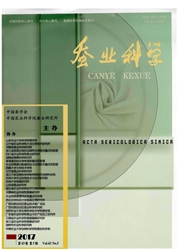

 中文摘要:
中文摘要:
花青素合成酶(anthocyanidin synthase,ANS)是植物花青素生物合成途径末端的关键酶,催化无色花色素到有色花色素的转变。从广东桑品种粤椹大10中克隆得到一条ANS序列,其ORF为1 077 bp,编码358个氨基酸,预测蛋白质分子质量为41 kD,等电点为5.62,具有2-酮戊二酸双加氧酶的保守结构域。多重序列比对表明物种间的ANS序列高度保守,系统进化树中桑树ANS与芍药科、芸香科、葡萄科等植物的同源序列聚在一个类群上。RT-PCR检测桑树ANS在结紫色果的粤椹大10的幼叶和桑椹中特异性表达,并且随着果色加深其表达水平呈上升趋势,而在结白色果的桑品种珍珠白的幼叶和桑椹中检测不到ANS的表达,暗示桑树ANS在桑椹的颜色形成中起到重要作用。
 英文摘要:
英文摘要:
Anthocyanidin synthase (ANS) is one of the key enzymes in the biosynthesis of plant anthocyanidin, which catalyzes conversion of leucoanthocyanidin into colored anthocyanidin. Here, we cloned an ANS sequence from Yueshenda 10, a mulberry variety of Morus atropurputea Roxb. This sequence had an ORF of 1077 bp which coded for 358 amino acids with predicted molecular weight of 41 kD and theoretical pl of 5.62. Domain prediction indicated that ANS had the conserved domain of 2-oxoglutarate dioxygenase. Multiple sequence alignment showed that ANS sequences were highly conserved among different species. Phylogenetic analysis showed that mulberry ANS clustered into one clade with those of Vitaceae, Paeoniaceae and Rutaceae. RT-PCR assay displayed that mulberry ANS was specifically expressed in young leaves and fruits of the purple fruit bearing Yueshenda 10 and the expression level increased with fruit maturation. No expression of ANS was detected in young leaves and fruits of the white fruit bearing Zhenzhubai, a mulberry variety of Morus alba, suggesting that mulberry ANS plays an important role in the formation of mulberry fruit color.
 同期刊论文项目
同期刊论文项目
 同项目期刊论文
同项目期刊论文
 Definition of Eight Mulberry Species in the Genus Morus by Internal Transcribed Spacer-Based Phyloge
Definition of Eight Mulberry Species in the Genus Morus by Internal Transcribed Spacer-Based Phyloge 期刊信息
期刊信息
